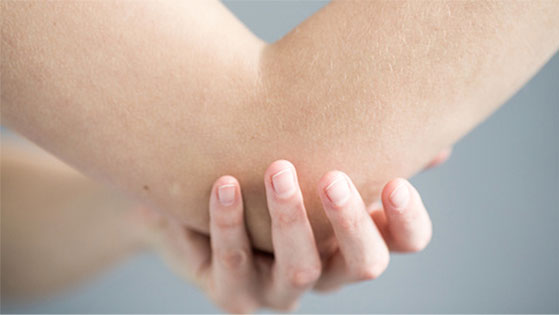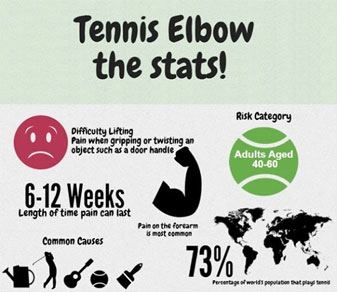

Lateral epicondylitis or tennis elbow as it is popularly called is a painful and disabling condition. In some people it can be so painful as to make them completely loose the use of their hands. There is no known precondition or predisposition to this pathology, but it seems to be more in people who are unaccustomed to physical work especially women beyond the age of 40 years. In India it is more often seen in the sedentary workers rather than in the tennis players as the name may suggest. Also seen in a lot of people who enthusiastically take up weightlifting and aggressive physical activity in a very short interval of time.


The pain is rather diffuse and is more over the back of the forearm especially over the elbow. It seems to be radiating from the elbow down to the wrist and is precipitated by doing exercises or lifting. Most people do not have any pain at rest but activity sometimes as simple as lifting a glass of water can also cause the pain.
Examination does not reveal much to note on inspection but pressing over the outer side of the elbow often causes pain. Pushing their wrist down precipitates pain which travels down from the elbow to the wrist. There are also some specific test which can be done to diagnose this condition.
Investigation: Doing routine x rays often does not show any findings at all and is not really required as it is a clinical diagnosis rather than Based on investigations. MRI scan can be done if there is any confusion in the diagnosis and might show some edema or mild evidence of tissue damage and fluid collection around the outer aspect of the elbow where the muscle arises from.
Pathophysiology: The cause of this damage is essentially repetitive stress or strain at the origin of the muscles/ tendon. The site of the pathology is the origin site of the muscles which lift the wrist and the fingers backwards. There is damage to the muscles/ tendon at this site. Normally the body has an ability to repair this injury but at times because of biomechanical reasons the healing might be delayed thus causing the pain and discomfort.
The options of treatment can be divided into
Non operative treatment should work in more than 90% of the patients. It involves change of lifestyle and putting less stress on the injured area. Patient can also do exercises for this which would be stretching of the extensor muscles and isometric strengthening of the muscles. Application of anti-inflammatory ointment and cold packs is also beneficial. Using a tennis elbow brace can be advocated if there is no relief of pain.

Surgical treatment involves debriding the injured muscle or even excising some of the injured muscle /tendon from around the Bone with or without reattachment of the muscle. The commonest muscle involved is the ECRB.
Newer options of treatment involve either giving extracorporeal shot wave therapy (ECSWT), use of lasers or presently more often prescribed injection of platelet rich plasma (PRP). The use of platelet rich plasma aims to provide healing cells to the damaged area which would then eventually release healthy chemicals to repair the site of the injury.
Pain which is quite disabling will get better given time and change of activity, but the period of acute pain however is disabling enough to warrant treatment.